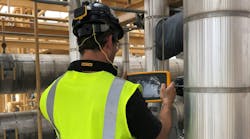Roundy’s Supermarkets is well known throughout Wisconsin, Minnesota and Illinois. The company’s 160 retail grocery stores and 88 pharmacies, known as Pick ’n Save, Rainbow, Copps, Metro Market and Mariano’s, employ more than 18,000 workers, with annual retail sales topping $4.0 billion.
Known for freshly prepared foods and broad deli selection, Roundy’s 120,000 square-foot food production plant in Kenosha, Wis., is a hybrid facility, encompassing under one roof meat processing, dairy foods manufacture, baked goods production, prepared drink bottling and deli food preparation. Selling high volumes of freshly prepared soups and salads, store delis require constant preparation of pasta and potatoes.
Starting in 2007, when Roundy’s first prepared fresh soups and salads, it relied on a chain-driven, semi-continuous conveyor batch system to cook and cool pasta and potatoes.
The former normal
For many years, water-spray conveyor systems were standard for cooking and cooling food products, but the systems have drawbacks. Lacking uniform water spray coverage, or enough agitation to keep pasta and vegetables separated during cook and chill, leads to uneven cooking and cooling insufficient to uniformly halt cooking.
"With potatoes, wedges and slices did not cook well," says Mario Jedwabnik, vice president, manufactured foods, Roundy’s. "They would stack up, and steam penetration was insufficient to cook through the layers. Cooling was another problem. We could not get enough water on the potatoes to cool them evenly."
"But the pasta was a nightmare," continues Jedwabnik. "Our conveyor baskets were 16" wide x 36" long, and the pasta tended to compact into them like a paste during the cooking and cooling. There was not enough circulation of water through the baskets to keep the pasta separated."
Different pastas require varied cooking times. Pasta needs to be cooled rapidly to stop its cooking. This is important to keep long pastas like fettuccine, linguine, tagliatelle and spaghetti from sticking together.
Downtime amounted to 30 percent of available production time due to shutdowns related to conveyor chain breaks or baskets separating from the chain and jamming inside the cooking and cooling chambers. Changeover times between potato cuts or pasta varieties took about one hour. Changeovers between potatoes and pasta, which required cleaning the system, took 2.5 hours to perform.
Jedwabnik says. "We were processing 600 to 700 pounds of potatoes per hour, and 1,000 pounds of pasta per hour. But it wasn’t enough."
Research leads to development
Roundy’s researched systems. One was a continuous rotary cooking and cooling design manufactured by Lyco Manufacturing. "We visited the Lyco plant in Columbus, Wis.," Jedwabnik says. "We discussed options and tested our potato and pasta products at their on-site test lab. The speed of processing and the quality of the finished product impressed us."
Roundy’s selected a Lyco Clean-Flow continuous-flow cooker and cooler system. The 7-foot long, 40-inch diameter Clean-Flow cooker was backed up by a 4-foot long, 40-inch Clean-Flow cooler, capable of moving 2,000 pounds of pasta or potatoes per hour. Potato throughput increased 300 percent and pasta throughput increased 100 percent.
An auger controls product retention time while a water-injection system agitates product and holds it in suspension. The continuous-flow cooking/cooling system has two completely enclosed continuous Clean-Flow units, one for cooking and one for cooling directly in sequence. The machines have internal augers to control dwell time in a wedge wire basket. The auger flights do not drag the product through the cooker and cooler system. Rather, pasta and potatoes are carefully agitated, while suspended in water, as they advance through the auger and basket. Damage to the potatoes and fragile pasta products is a fraction of 1 percent.
Once product has passed through the cooker machine, in a first-in/first-out sequence, the potatoes or pasta are gently deposited in the cooler, and chilled to temperature. The product is then discharged. The cooler runs at 50 to 60 F, which stops the potatoes or pasta from further cooking.
Roundy’s clean-up time is improved 300 percent, from 2.5 hours with the old system to 45 minutes, because the auger is totally exposed for cleaning. During clean-up, the screen is released from its fixed position, and is continually rotated 360 degrees around the auger, alternately exposing the interior and exterior of the screen to clean-in-place manifolds located in the cover of the machine. The auger can be rotated at the same time as the screen, again exposing all surfaces to the cleansing water sprays.
Expanded capacity
By early 2012, Roundy’s product demand for potatoes and pasta increased dramatically, exceeding capacity on its 12-month-old cooker/cooler system. "We went back to Lyco’s engineering team to reevaluate our needs," Jedwabnik says. "We emerged with an upgraded Clean-Flow system capable of processing 3,000 pounds of potatoes per hour, and 3,500 pounds of pasta, which is significantly more than our previous system."
In fact, the new Clean-Flow cooker/cooler system can process more than 400 percent more potatoes per hour, and more than 300 percent more pasta per hour compared to Roundy’s original conveyor batch system, with virtually zero product defect, and near-zero downtime from malfunction.
"Aside from the sizable increase in throughput volume, the product coming out of the new Clean-Flow cooker/cooler is consistent," continued Jedwabnik. "We are very pleased with the system’s performance."
Jim McMahon writes on emerging technologies in food processing.
Lyco Manufacturing is a maker of cooking and cooling equipment for food processors. World-class metal manufacturing lasers, precision press brakes and robot welders enhance quality and reduce cost for systems made in the food and fabrication divisions of the company. Founded in 1980 by the owner and Chairman of the Board, David R. Zittel, Lyco Manufacturing is housed in a state-of-the-art 80,000 square-foot facility in Columbus, Wis.



